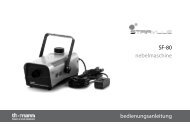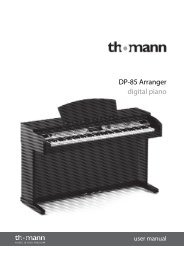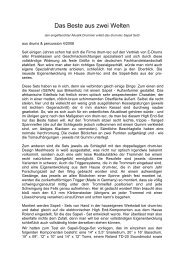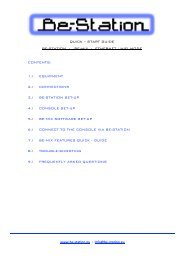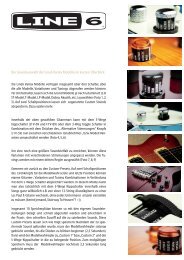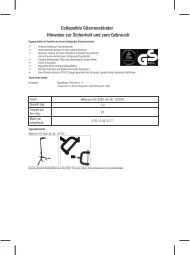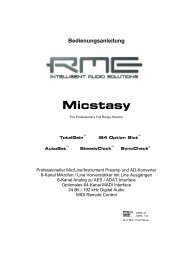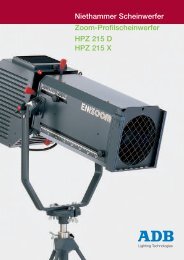Create successful ePaper yourself
Turn your PDF publications into a flip-book with our unique Google optimized e-Paper software.
12:7 Routing scenarios<br />
Creating sub-mixes for processing mic channels together<br />
You may want to process a number of mic channels together through the same set of FX. Let’s say you want to group the kick in<br />
and kick out channels, and apply some parallel compression to them.<br />
• Create an aux bus and set it to mono mode.<br />
• Set the kick in and kick out Output selector to the Aux channel you just created.<br />
• Adjust the levels of the kick in and kick out channels to achieve the desired balance between them.<br />
• Insert a compressor in one of the Aux channel’s FX slots and set the controls as required.<br />
• Set the Wet/Dry blend control to achieve the desired balance between the compressed and uncompressed signal.<br />
• There are many possibilities for sub-mixing – you may want to create stereo sub-mixes for all the toms or cymbals, for example.<br />
By using the ambience send routing controls in the kit-piece inspector, you can even route the ambience signals for these kitpieces<br />
to the same aux channel, or a separate set of kit-piece specific ambience channels.<br />
Mic channel separation<br />
If you want to send each mic channel out of the BFD2 plugin into your host’s mixer without performing any mixing or processing in<br />
BFD2’s mixer, proceed as follows:<br />
• Set each kit-piece’s direct mic channels to an individual output. Since they are mono, it is recommended that you use mono<br />
output routings.<br />
• Set each ambience bus to a pair of stereo outputs from the plugin.<br />
• BFD2 has 16 mono outputs and 8 stereo outputs, so if you are using a large amount of kit-pieces you need to route some direct<br />
channels through the same outputs. You can set more than one channel to the same output, although it can be more manageable<br />
to route the required channels to an Aux channel to set up a sub-mix, and route this channel to the appropriate output.<br />
• There are no rules about how you should set up your routing – everything depends on your creative needs and what you want to<br />
achieve.<br />
• Once you have separated out the mic channels to individual outputs from BFD2, set up your host’s mixer to receive them. See<br />
your host’s documentation for details of how your host implements this functionality – BFD2 operates in the same way as any<br />
multiple output plugin.<br />
• You can then process the mic channels through whatever plugins you choose in your host, route the channels out of your audio<br />
interface’s physical outputs in order to use external processors and effects units, or simply record them as audio tracks.<br />
Creating sends to an external reverb<br />
If you have invested in a high quality reverb plugin or hardware unit, it is very simple to set up one of BFD2’s outputs as an external<br />
aux send.<br />
• Create a stereo aux channel.<br />
• Create a send on each of the direct mic channels that you want to send to the reverb, and enable them.<br />
• For each Send, set the Send To destination to the Aux channel you created earlier, and Set up the Send From routing and the<br />
send level as required.<br />
• Set the output selector of the Aux channel to one of BFD2’s stereo outputs<br />
• Set up your host to receive this stereo output on one of its mixer channels. See your host’s documentation for details of how<br />
your host implements this functionality – BFD2 operates in the same way as any multiple output plugin.<br />
• You can then insert a reverb plugin on this signal, or route it from your audio interface’s physical outputs to a hardware reverb<br />
unit.<br />
• You can still route the original direct mic channels within BFD2 for further mixing and processing.<br />
• The above method is usable for any type of parallel processing – for example parallel compression. Simply create the desired<br />
mono or stereo sub-mixes using the output and/or send routing functions, and route the sub-mixes out of BFD2 for further<br />
processing.<br />
1



